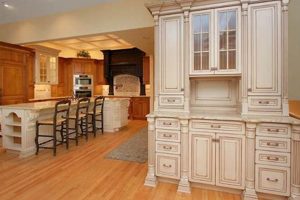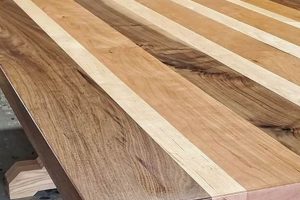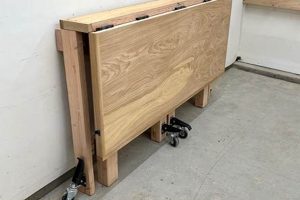The intersection of specialized carpentry and renovation services provides tailored solutions for residential and commercial spaces. This area encompasses the design, fabrication, and installation of unique wooden features, alongside the modernization or restructuring of existing structures. Examples include bespoke cabinetry, intricate molding, and the complete overhaul of kitchens and bathrooms to meet specific client needs and preferences.
Such services deliver increased property value, enhanced aesthetic appeal, and improved functionality. Historically, skilled artisans have been integral to construction, shaping interiors and exteriors with handcrafted elements. Modern applications provide personalization and optimization, contrasting with mass-produced alternatives, and often incorporating sustainable practices and materials for long-term cost-effectiveness.
The following sections will delve into specific aspects of high-end carpentry and comprehensive renovation projects, exploring the processes, considerations, and potential outcomes that define successful execution.
Guidance from Experts in Tailored Carpentry and Renovation
The following guidance addresses critical considerations for those undertaking bespoke woodworking projects and comprehensive remodeling initiatives.
Tip 1: Define Project Scope Precisely: Thoroughly outline project parameters, including specific objectives, budgetary constraints, and desired timelines. This prevents scope creep and ensures alignment among stakeholders.
Tip 2: Prioritize Material Selection: Opt for high-quality materials that align with the project’s aesthetic and functional requirements. Consider durability, sustainability, and long-term maintenance costs when making selections.
Tip 3: Emphasize Detailed Planning: Develop comprehensive plans, including detailed drawings and specifications. This reduces the likelihood of errors during execution and facilitates accurate cost estimation.
Tip 4: Adhere to Building Codes and Regulations: Ensure strict adherence to all applicable building codes and regulatory requirements. This mitigates legal risks and safeguards structural integrity.
Tip 5: Implement Effective Project Management: Employ rigorous project management practices to monitor progress, manage resources, and address potential challenges proactively. This promotes efficient execution and on-time delivery.
Tip 6: Maintain Clear Communication: Foster open and transparent communication among all parties involved, including contractors, suppliers, and clients. This minimizes misunderstandings and facilitates informed decision-making.
Tip 7: Conduct Thorough Inspections: Perform regular inspections throughout the project lifecycle to identify and rectify any defects or deficiencies promptly. This ensures quality control and prevents long-term issues.
Careful adherence to these guidelines will promote successful project outcomes, optimizing investment and enhancing the longevity and value of the completed work.
The next segment will address common challenges encountered in upscale woodworking and renovation endeavors, providing strategies for their effective resolution.
1. Precision
In the realm of tailored carpentry and renovation, precision is not merely a desirable attribute but a fundamental prerequisite for success. Precision directly impacts the structural integrity, aesthetic appeal, and overall functionality of any project. A lack of precision in measurements, cuts, or installations can result in misaligned components, weakened structures, and a compromised final product. Consider, for instance, the installation of custom cabinetry. Even a slight deviation from specified dimensions can lead to ill-fitting doors, drawers that do not function smoothly, and gaps that detract from the intended aesthetic.
The effect of precision extends beyond purely visual considerations. Precise joinery in structural elements ensures load-bearing capacity and stability. Inaccurate cuts can compromise the integrity of support beams or framing, potentially leading to safety hazards. Furthermore, precision is essential for efficient material usage. Accurate measurements minimize waste and reduce the overall cost of the project. For example, a custom-built staircase requires meticulous calculations to ensure consistent rise and run for each step. Any error in these calculations will result in an unsafe and aesthetically unappealing staircase.
Ultimately, precision in the context of sophisticated carpentry and renovation translates to a commitment to quality and enduring value. While challenges such as unforeseen structural complexities or variations in material density may arise, the unwavering pursuit of accuracy remains paramount. This focus on precision, combined with expert craftsmanship, ensures that each project not only meets but exceeds expectations, delivering lasting beauty and functionality.
2. Durability
Durability serves as a cornerstone of quality in specialized carpentry and renovation services. It dictates the lifespan and resilience of structures and features produced. Material selection is a critical factor; hardwoods like oak and maple offer greater resistance to wear and tear than softer woods such as pine. Treatment processes, including sealing and finishing, protect wood from moisture, insects, and environmental damage, directly impacting longevity.
The correlation between expert craftsmanship and material durability determines the long-term performance of the output. For instance, a custom-built deck constructed with pressure-treated lumber and properly sealed exhibits superior resistance to decay and insect infestation, extending its lifespan and minimizing maintenance requirements. Similarly, kitchen cabinetry crafted from high-density fiberboard (HDF) with a durable finish withstands daily use and exposure to moisture, preventing warping and peeling. The application of appropriate joinery techniques, such as dovetail joints, significantly enhances the structural integrity of furniture and millwork, ensuring robustness and stability over time.
In summation, the integration of durable materials, coupled with the meticulous application of protective treatments and robust construction techniques, underpins the enduring value of specialized carpentry and renovation projects. Understanding these principles enables informed decision-making regarding material selection, design implementation, and maintenance practices, thereby maximizing the longevity and minimizing the long-term costs associated with custom-crafted wooden features and renovated spaces.
3. Aesthetics
Aesthetics represent a pivotal component within the realm of specialized carpentry and renovation. The intrinsic visual appeal of a finished project directly influences its perceived value and the overall satisfaction of the client. Consideration of aesthetic principles extends beyond mere surface-level decoration; it encompasses the harmonious integration of form, material, and function to create spaces and features that are both visually pleasing and contextually appropriate. For example, in a kitchen renovation, the choice of cabinet door styles, countertop materials, and backsplash tile patterns significantly contributes to the overall aesthetic. A cohesive design scheme, carefully selected color palettes, and balanced proportions can transform a utilitarian space into a visually captivating and inviting environment. Failure to adequately consider aesthetics can result in a disjointed and unappealing final product, regardless of the structural integrity or functional efficiency of the project.
The application of aesthetic principles is not merely a subjective exercise; it requires a comprehensive understanding of design theory, architectural styles, and the interplay of light, color, and texture. Skilled carpenters and renovators possess the ability to translate abstract design concepts into tangible realities, considering factors such as natural light exposure, spatial flow, and the surrounding architectural context. For instance, in a custom woodworking project involving the creation of a built-in bookshelf, the selection of wood species, finish, and hardware is crucial for achieving the desired aesthetic. A dark wood finish might evoke a sense of traditional elegance, while a lighter finish can create a more modern and airy feel. The proportions of the shelves, the spacing between them, and the integration of lighting elements all contribute to the overall aesthetic impact of the bookshelf.
In conclusion, the deliberate incorporation of aesthetic considerations is paramount to the success of specialized carpentry and renovation endeavors. It necessitates a collaborative approach, involving close communication between the carpenter or renovator and the client, to ensure that the final product aligns with the client’s vision and enhances the overall value and appeal of the space. The commitment to aesthetic excellence transforms functional spaces into works of art, enriching the lives of those who inhabit them.
4. Functionality
Functionality forms an indispensable cornerstone of any sophisticated carpentry and renovation project. It dictates the practical usability and efficiency of the redesigned or newly constructed space. The absence of functional design compromises the value and longevity of even the most aesthetically pleasing or structurally sound undertaking. The impact of functionality extends beyond mere convenience; it directly influences user experience, safety, and the overall utility of the built environment. A kitchen remodel, for example, must prioritize workflow efficiency, adequate storage solutions, and ergonomic counter heights. Failure to consider these functional aspects results in a visually appealing but ultimately impractical and frustrating space to operate within.
The application of functional principles involves a thorough understanding of user needs, spatial dynamics, and building codes. Skilled carpenters and renovators possess the capacity to translate these needs into tangible design solutions, optimizing space utilization and enhancing accessibility. Consider a custom-built home office designed for a remote worker. Functionality dictates the inclusion of ample storage for documents and equipment, strategically placed power outlets for electronic devices, and ergonomic furniture designed for prolonged use. The layout should promote focus and minimize distractions, while the design should integrate seamlessly with the overall aesthetic of the home. Another practical application lies in bathroom remodeling, where functional elements such as slip-resistant flooring, accessible shower designs, and efficient ventilation systems contribute to safety and comfort.
In summary, the careful consideration of functionality is essential for the success of specialized carpentry and renovation projects. It requires a collaborative approach, ensuring that the design aligns with the client’s specific needs and the intended use of the space. By prioritizing functional design alongside aesthetics and structural integrity, carpenters and renovators deliver lasting value and enhance the quality of life for those who inhabit the spaces they create. Challenges such as budget constraints or unforeseen structural limitations can often be overcome through innovative design solutions that prioritize functionality without compromising aesthetics or safety.
5. Integration
Integration, in the context of specialized carpentry and renovation services, signifies the seamless incorporation of new or modified elements within an existing structure or design scheme. This process requires careful consideration of the surrounding environment and pre-existing architectural characteristics to ensure a cohesive and harmonious final product. Successful integration is not merely about adding new features but about ensuring they complement and enhance the existing fabric of the space.
- Architectural Harmony
Architectural harmony involves aligning new woodwork or renovated spaces with the established style and period of the existing structure. This includes matching materials, finishes, and design motifs to maintain a consistent aesthetic. For example, integrating custom-built cabinetry into a Victorian-era home necessitates the use of appropriate wood species, detailing, and hardware that reflect the historical character of the property. Failure to achieve architectural harmony results in jarring juxtapositions that detract from the overall aesthetic appeal.
- Functional Cohesion
Functional cohesion ensures that new or modified elements seamlessly integrate with the existing functional systems of the building. This includes plumbing, electrical, and HVAC systems. For instance, when remodeling a kitchen, it is essential to integrate new appliances, lighting, and ventilation systems with the existing infrastructure without disrupting the functionality of other areas of the home. Careful planning and coordination are required to avoid potential conflicts and ensure efficient operation.
- Spatial Optimization
Spatial optimization involves maximizing the use of available space and ensuring that new elements enhance the flow and usability of the area. This requires a comprehensive understanding of spatial dynamics and the ability to create designs that are both aesthetically pleasing and functionally efficient. For example, integrating custom storage solutions into a small apartment requires careful consideration of space-saving designs and innovative organizational techniques. The goal is to create a sense of spaciousness and order, without sacrificing essential functionality.
- Material Compatibility
Material compatibility dictates the selection of materials that are compatible with the existing building materials in terms of appearance, durability, and environmental impact. Incompatible materials can lead to premature deterioration, structural issues, and aesthetic disharmony. For instance, integrating new wood flooring into a home with existing hardwood floors requires careful matching of wood species, grain patterns, and finishes to ensure a seamless transition. The use of sustainable and environmentally friendly materials is also an important consideration in modern building practices.
The facets discussed underscore that the effective blending of materials, functionalities, and design elements elevates the overall value and aesthetic coherence of any project. Diligent planning and execution ensures project integrates harmoniously, maintaining its value and aesthetic appeal for years to come.
6. Sustainability
The integration of sustainable practices within specialized carpentry and renovation is increasingly crucial, driven by environmental concerns and a growing demand for responsibly sourced and manufactured products. Implementing sustainability principles offers ecological benefits and can enhance the value and appeal of projects to environmentally conscious clients.
- Sustainable Material Selection
The selection of sustainably harvested wood, reclaimed lumber, and eco-friendly finishes is paramount. Certified wood sources, such as those endorsed by the Forest Stewardship Council (FSC), ensure responsible forest management practices. Reclaimed lumber reduces demand for newly harvested timber, mitigating deforestation and carbon emissions. Low-VOC (volatile organic compound) finishes minimize indoor air pollution, promoting healthier living environments. For example, using bamboo, a rapidly renewable resource, for cabinetry construction reduces reliance on traditional hardwoods.
- Energy Efficiency Enhancements
Incorporating energy-efficient features during renovation projects reduces environmental impact and lowers long-term operating costs. Implementing energy-efficient windows, insulation, and HVAC systems minimizes energy consumption. Smart home technology can further optimize energy usage through automated lighting and temperature control. For instance, installing Energy Star-certified appliances in a kitchen remodel significantly reduces energy consumption compared to older, less efficient models.
- Waste Reduction and Recycling
Implementing effective waste management practices minimizes environmental impact during construction and demolition. Recycling construction debris, such as wood, metal, and concrete, reduces landfill waste and conserves resources. Deconstruction, rather than demolition, allows for the salvage of reusable materials. For example, during a bathroom renovation, salvaging and repurposing fixtures like sinks and bathtubs reduces waste and preserves valuable resources.
- Water Conservation Strategies
Integrating water conservation measures into renovation projects reduces water consumption and promotes environmental stewardship. Installing low-flow fixtures, such as toilets, showerheads, and faucets, minimizes water usage without compromising performance. Rainwater harvesting systems can provide a sustainable source of water for irrigation and non-potable uses. For example, installing a dual-flush toilet in a bathroom renovation can significantly reduce water consumption compared to traditional models.
The synergy between sustainability and specialized carpentry and renovation extends beyond individual projects, fostering a broader commitment to environmental responsibility. By embracing sustainable practices, carpenters and renovators contribute to a more ecologically sound built environment, meeting the evolving needs and expectations of clients seeking environmentally conscious solutions. The application of these tenets ultimately promotes resource conservation and overall environmental quality.
Frequently Asked Questions
The following addresses common inquiries regarding specialized carpentry and renovation services. These responses are intended to provide clarity and inform decision-making for potential clients.
Question 1: What factors determine the cost of such projects?
Project expenses are influenced by material selection, project scope, design complexity, and labor requirements. Premium materials, intricate designs, and extensive renovations invariably increase costs. Geographic location and prevailing market rates also play a significant role.
Question 2: How long does a typical woodworking or renovation project take?
Project duration varies based on the scale and complexity of the work involved. Small-scale woodworking projects may require days or weeks, while comprehensive renovations can span several months. Detailed timelines are typically provided following a thorough assessment of the project requirements.
Question 3: Is it necessary to obtain permits for renovation work?
Permit requirements depend on local building codes and the nature of the renovation. Structural alterations, electrical work, and plumbing modifications typically necessitate permits. Failure to obtain required permits can result in fines and project delays.
Question 4: What guarantees are offered on craftsmanship and materials?
Warranty provisions vary among providers. Reputable firms offer guarantees on both workmanship and materials, covering defects and premature failure. Specific warranty terms are typically outlined in the project contract.
Question 5: How can one ensure effective communication throughout the project?
Clear and consistent communication is paramount. Regular progress updates, site meetings, and prompt responses to inquiries facilitate effective project management. Establishing a designated point of contact streamlines communication and ensures accountability.
Question 6: What measures are taken to minimize disruption during renovation work?
Minimizing disruption is a priority. Protective measures, such as dust barriers and floor coverings, mitigate mess and damage. Scheduling work during off-peak hours and maintaining a clean worksite further reduce inconvenience.
Understanding these aspects facilitates informed decision-making and fosters a successful partnership between the client and the service provider.
The subsequent section explores strategies for selecting a qualified professional.
Conclusion
The preceding discussion has provided an overview of “custom craft woodworks & remodeling,” addressing its definition, benefits, critical considerations, and frequently asked questions. The significance of precision, durability, aesthetics, functionality, integration, and sustainability has been emphasized as fundamental aspects that influence the success of such endeavors. The information underscores the importance of careful planning, skilled execution, and adherence to industry best practices.
Given the complexities inherent in specialized carpentry and renovation, entrusting projects to qualified professionals is essential. Meticulous attention to detail, coupled with a commitment to quality, ensures that the results not only meet expectations but also provide lasting value and satisfaction. Prospective clients are encouraged to conduct thorough due diligence when selecting service providers, prioritizing experience, expertise, and a proven track record of successful project completion.







